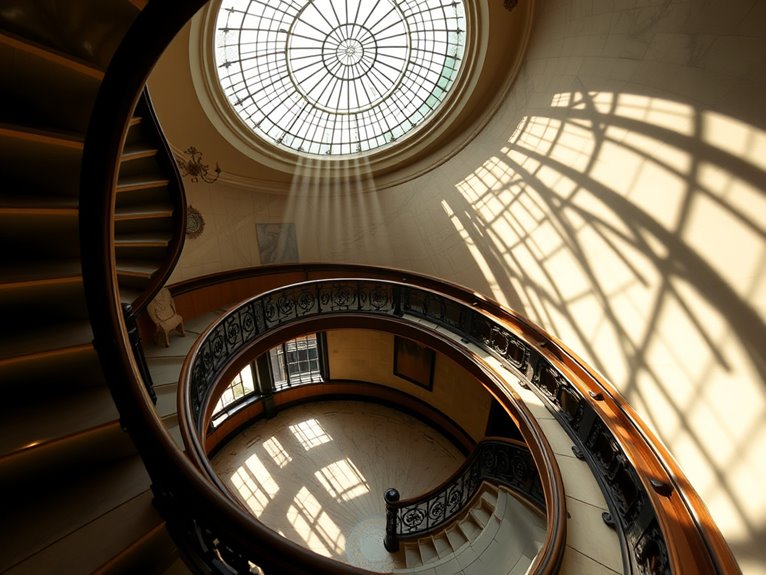
8 Architectural Marvels in Paris Beyond the Monuments
I've discovered eight incredible architectural gems in Paris that most tourists miss! Beyond the Eiffel Tower, you'll find the Art Deco Théâtre des Champs-Élysées with its stunning concrete design, the Japanese-inspired La Pagode cinema, Le Marais's hidden medieval courtyards, and the futuristic Institut du Monde Arabe. Don't forget Le Corbusier's Villa Savoye, Saint-Pierre de Chaillot church, the revolutionary Glass House, and Frank Gehry's Fondation Louis Vuitton. Let's explore these lesser-known masterpieces that showcase Paris's architectural evolution.
The Art Deco Splendor of Théâtre Des Champs-Élysées
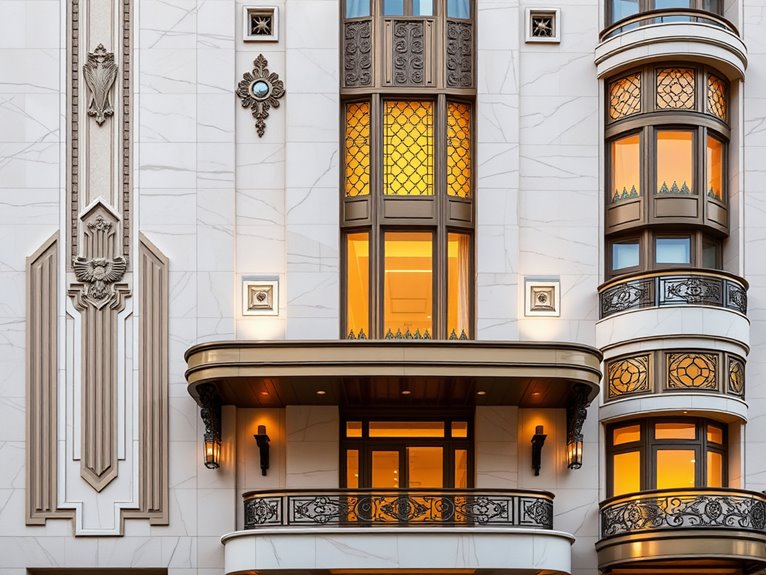
Standing proudly on Avenue Montaigne since 1913, the Théâtre des Champs-Élysées represents one of Paris's most significant Art Deco landmarks and a revolutionary moment in French architecture. Unlike its ornate Beaux-Arts contemporaries, this modernist masterpiece broke tradition by embracing clean lines, geometric patterns, and innovative construction techniques, becoming the first major Parisian building made primarily of reinforced concrete.
The theater gained immediate notoriety as the site of the infamous premiere of Stravinsky's "The Rite of Spring," where the avant-garde performance sparked a near-riot among the audience. Today, this architectural gem continues to captivate visitors with its harmonious blend of Art Deco aesthetics, featuring Antoine Bourdelle's magnificent facade reliefs and Maurice Denis's stunning dome paintings, while serving as a premier venue for classical music, opera, and dance performances.
Quick Facts:
- Opening Hours: 11:00 AM – 7:00 PM (guided tours)
- Performance Times: Usually 8:00 PM
- Ticket Prices: €15-150 (performances), €12 (guided tours)
- Photography: Allowed in common areas; prohibited during performances
- Best Viewing Times: Late afternoon for ideal facade lighting
- Accessibility: Elevator access available
- Dress Code: Smart casual for tours, formal for evening performances
Main Features:
The Facade
The building's limestone exterior showcases Bourdelle's masterful bas-reliefs depicting scenes from classical mythology and the performing arts. The geometric patterns and streamlined design revolutionized Parisian architecture, marking a clear departure from the elaborate Beaux-Arts style. Insider tip: The reliefs are best photographed during the "golden hour" before sunset when the raking light creates dramatic shadows.
The Main Auditorium
The 1,905-seat auditorium combines superior acoustics with Art Deco elegance, featuring a stunning cupola decorated by Maurice Denis. The innovative use of reinforced concrete allowed for unobstructed views from every seat. Hidden detail: Look for the original brass air vents beneath the seats, part of an advanced ventilation system that was revolutionary for its time.
The Coupole Restaurant
Located on the theater's top floor, this Art Deco restaurant offers panoramic views of Paris while serving classic French cuisine. The original 1913 decorative elements remain largely intact, including period lighting fixtures and mirrors. Reservation tip: Request table 14 for the best view of the Eiffel Tower.
Pro Tips:
For the most immersive experience, book a behind-the-scenes tour on Tuesday mornings when rehearsals often take place, offering glimpses of performers preparing for upcoming shows. Combine your visit with a pre-performance dinner at the Coupole Restaurant, but reserve at least three weeks in advance during peak season (September-December).
Practical Advice:
The theater is located in the 8th arrondissement, easily accessible via Metro stations Alma-Marceau or Franklin D. Roosevelt. While the building's historical significance attracts architecture enthusiasts year-round, the ideal visiting period is during the fall performance season when the full artistic program showcases the venue's acoustic excellence and architectural splendor in harmony. Purchase performance tickets well in advance, as popular shows often sell out months ahead.
La Pagode: A Japanese Temple in the Heart of Paris
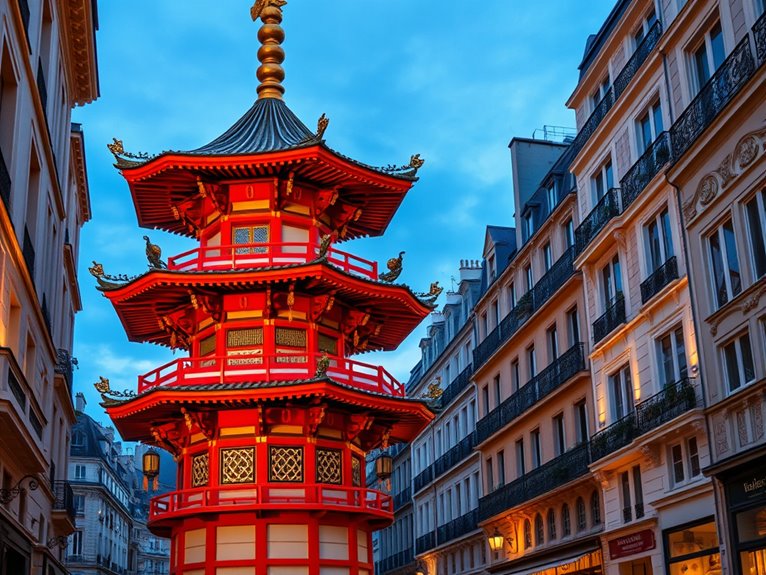
Nestled in the sophisticated 7th arrondissement of Paris, La Pagode stands as one of the city's most unexpected architectural treasures. This Japanese-inspired cinema and cultural venue, built in 1896, represents a stunning fusion of Asian and European architectural styles that has captivated visitors for over a century. Originally constructed as a wedding gift from François-Émile Morin to his wife, the building has evolved from a private ballroom to an art house cinema while maintaining its exotic charm.
The structure's remarkable journey from personal extravagance to beloved cultural institution mirrors Paris's own evolution as a global city. With its authentic Japanese decorative elements, including carved wooden panels, delicate paintings, and a meticulously maintained Japanese garden, La Pagode offers visitors a unique opportunity to experience an elegant slice of the Far East in the heart of the French capital.
Quick Facts:
- Opening Hours: Tuesday-Sunday, 11:00 AM – 11:00 PM
- Admission: €12 for cinema screenings; garden viewing €5
- Best Time to Visit: Late afternoon for ideal garden lighting
- Photography: Allowed in garden; prohibited during screenings
- Accessibility: Limited; main floor accessible, upper levels via stairs
- Address: 57 Rue de Babylone, 75007 Paris
- Metro: Saint-François-Xavier (Line 13)
The Cinema Experience
La Pagode's main screening room preserves much of its original Belle Époque splendor, featuring ornate ceiling decorations, authentic Japanese lanterns, and plush red velvet seating. The venue specializes in independent and art house films, often presenting both contemporary and classic films in their original language with French subtitles. Insider tip: Request seats in the balcony area for the best views of both the screen and the room's architectural details.
The Japanese Garden
The surrounding garden, designed by Japanese landscape architects, provides a peaceful retreat from urban Paris. Featuring traditional elements such as stone lanterns, bamboo groves, and a small koi pond, the garden is particularly magical during spring when cherry blossoms bloom. The garden can be visited independently of film screenings, though combination tickets offer better value.
Pro Tips:
Visit during weekday afternoons to avoid the larger weekend crowds, and consider timing your visit to coincide with the "golden hour" before sunset when the garden's features are particularly photogenic. For the fullest experience, combine a garden visit with an evening film screening, arriving at least 45 minutes before showtime to explore the architecture and enjoy the garden's tranquility.
Practical Advice:
Advance booking is recommended for film screenings, particularly for weekend showings and special events. The neighborhood offers numerous high-end dining options, but consider bringing a small picnic to enjoy in the garden (permitted outside of screening hours). While the venue is accessible by public transport, parking can be challenging in this residential area, so utilizing the Metro is strongly recommended. Remember that the garden may close during inclement weather, so checking the forecast before visiting is advisable.
Hidden Courtyards of Le Marais: Medieval Architectural Gems
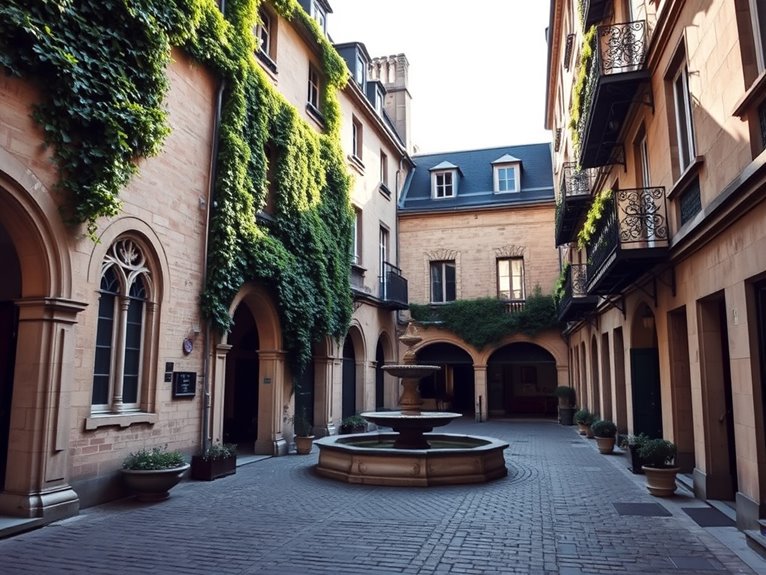
Behind the stately facades of Le Marais district lies a secret world of medieval courtyards, each telling tales of Paris's aristocratic golden age. These hidden architectural treasures, tucked away behind heavy wooden doors and through stone archways, represent some of the finest preserved examples of medieval and Renaissance architecture in Paris, dating back to the 13th century.
Walking through Le Marais's hidden courtyards feels like stepping into a time capsule, where ornate fountains, detailed sculptures, and centuries-old stone masonry transport visitors to an era when this district served as the preferred residence of French nobility. Each courtyard offers unique architectural elements, from Gothic arches to Renaissance columns, providing photographers and history enthusiasts with countless opportunities to explore Paris's architectural heritage.
Quick Facts:
- Best visiting hours: 10 AM – 6 PM (many courtyards close at sunset)
- Access: Free, but some require advance arrangement or guided tours
- Photography: Permitted in most courtyards, tripods often restricted
- Best season: Spring and fall for ideal lighting and fewer tourists
- Accessibility: Most courtyards involve cobblestones and steps
Notable Courtyards:
Hôtel de Sully (62 Rue Saint-Antoine)
This 17th-century mansion showcases perfect symmetry and classical French architecture. Its two consecutive courtyards feature intricate stone carvings and perfectly manicured gardens. The orangerie and original stone well remain intact. Insider tip: Visit during the first Sunday of each month for free access to the private gardens normally closed to the public.
Hôtel Carnavalet (23 Rue de Sévigné)
Housing the Museum of Paris History, this courtyard combines medieval and Renaissance styles. The entrance features unique carved stone masks representing the four seasons. Access is free to the courtyard, even without museum entry. Insider tip: Look for the original 16th-century spiral staircase in the far corner, often overlooked by visitors.
Hôtel de Sens (1 Rue du Figuier)
One of the finest examples of medieval civil architecture, featuring Gothic windows and a remarkable turret. The courtyard includes a medieval garden with historically accurate plantings. Insider tip: The building still bears a cannonball from the 1830 revolution – look for it embedded in the facade.
Pro Tips:
Early morning visits (before 11 AM) offer the best photography opportunities when sunlight creates dramatic shadows across the architectural details. Many courtyards are technically public spaces but appear private; don't be intimidated by closed doors – if they're accessible during business hours, visitors are typically welcome to enter respectfully. Consider joining a specialized architectural walking tour for access to normally restricted courtyards.
Practical Advice:
Create a mapped route before exploring, as many courtyards are easy to miss. Carry a detailed street map of Le Marais, as GPS signals can be unreliable in narrow streets. Most courtyards are accessible Monday through Friday, with limited weekend access. Remember to keep voices low and respect private areas, as many buildings still serve as residences or offices. Photography is generally allowed, but always check for posted restrictions and be mindful of residents' privacy.
The Futuristic Design of Institut Du Monde Arabe
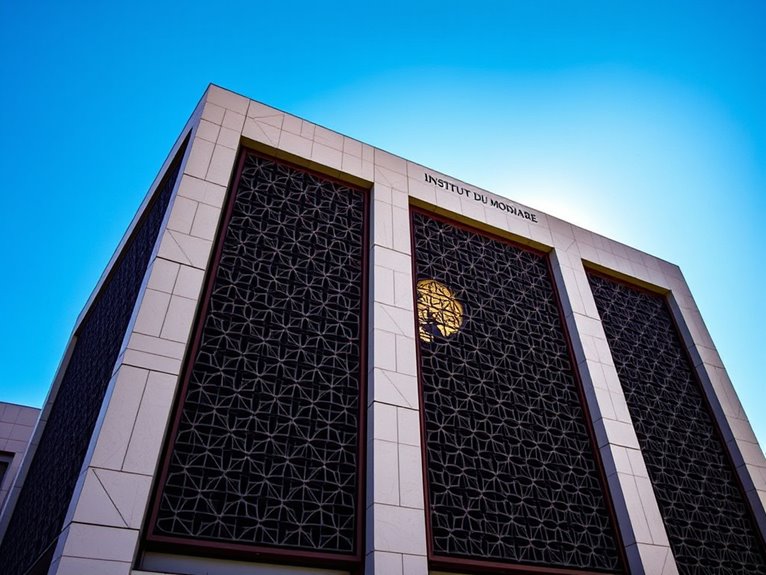
Standing boldly on the Left Bank of Paris, the Institut du Monde Arabe (IMA) represents a masterful fusion of contemporary architecture and traditional Arabic design principles. Completed in 1987 by architects Jean Nouvel and Architecture-Studio, this cultural bridge between France and the Arab world showcases revolutionary architectural innovation through its distinctive mechanical façade and geometric patterns.
The building's most striking feature is its southern wall, comprising 240 motorized geometric apertures that automatically adjust to control light penetration, mimicking traditional Arabic mashrabiya screens. This dynamic interplay of light and shadow not only serves a practical purpose but also creates an ever-changing visual experience that has made the IMA one of Paris's most photographed modern structures.
Quick Facts:
- Opening Hours: Tuesday-Sunday, 10:00 AM – 6:00 PM
- Best Visiting Time: Mid-morning or late afternoon for ideal light effects
- Photography Tips: External shots best during golden hour; interior around noon
- Admission: €8-12 (varies by exhibition)
- Accessibility: Fully wheelchair accessible
- Languages: Information available in French, English, and Arabic
The Mechanical Façade:
The building's south-facing wall features photosensitive metallic diaphragms that operate like camera shutters, automatically adjusting to sunlight levels. These 30,000 mechanical components create intricate geometric patterns while regulating interior temperature and light. The best time to observe this technological marvel is during changing light conditions, particularly around 11 AM when the mechanisms are most active.
Rooftop Terrace:
The ninth-floor terrace offers panoramic views of Paris, including Notre-Dame and the Seine. Access is included with general admission, but few visitors know about the weekly sunset photography sessions organized during summer months. The terrace also houses Le Zyriab restaurant, offering high-end Arabic fusion cuisine with spectacular views.
Exhibition Spaces:
The institute houses both permanent and temporary exhibitions across its seven floors. The permanent collection showcases Arab-Islamic art and scientific achievements, while rotating exhibitions feature contemporary Middle Eastern artists. One hidden gem is the medieval science exhibition in the basement, featuring working replicas of historical Arabic astronomical instruments.
Pro Tips:
Visit on the first Sunday of each month for free admission and special cultural programming. For the best photographic opportunities of the mechanical façade, arrive just before sunset when the lowering sun creates dramatic shadows through the geometric patterns. The building's quietest times are typically Tuesday and Thursday mornings, ideal for unhurried exploration of the exhibitions.
Practical Advice:
Access the IMA via Metro station Jussieu (lines 7 and 10) or Cardinal Lemoine (line 10). Consider purchasing tickets online to avoid queues, especially during temporary exhibitions. The building's orientation can make navigation confusing; pick up a floor plan at the information desk and start your visit from the top floor, working your way down. The on-site bookstore offers one of Paris's best selections of Arab world literature and art books, with many English translations available.
Villa Savoye: Le Corbusier's Modernist Masterpiece
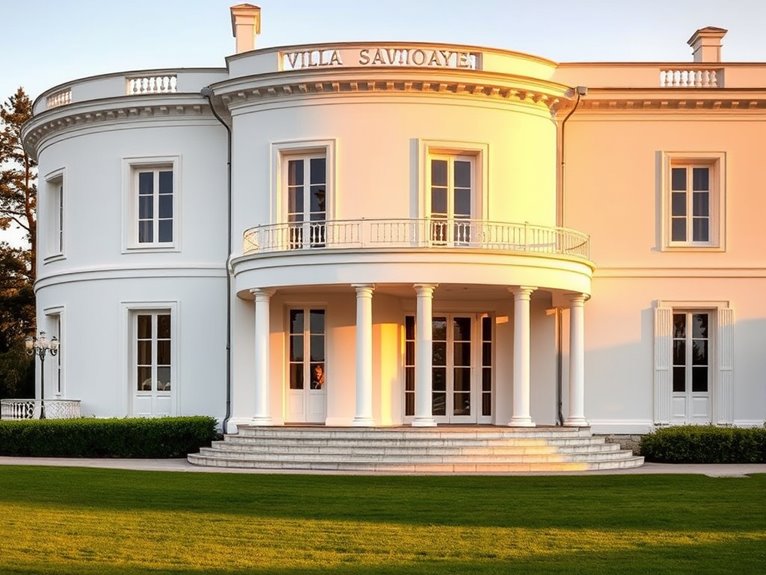
Architectural Marvels in Paris: Villa Savoye
Le Corbusier's Modernist Masterpiece
Perched atop a grassy meadow in Poissy, just outside Paris, Villa Savoye stands as one of the most influential buildings of the 20th century. Completed in 1931, this revolutionary house embodies Le Corbusier's "Five Points of Architecture" and represents the pinnacle of International Style modernism, transforming residential architecture forever.
The pristine white villa, with its distinctive pilotis (support columns), horizontal windows, and geometric forms, was commissioned by the Savoye family as a weekend retreat. Today, it serves as a museum and architectural pilgrimage site, offering visitors an unprecedented glimpse into Le Corbusier's vision of modern living and his profound impact on contemporary architecture.
Quick Facts:
- Opening Hours: 10:00 AM – 6:00 PM (Closed Mondays)
- Admission: €8 adults, free for under 18
- Best Time to Visit: Early morning for ideal natural light
- Photography: Allowed inside and out, tripods require permission
- Accessibility: Elevator available, wheelchair accessible
- Transport: 40 minutes from central Paris via RER A
- Audio Guide: Available in multiple languages (€3)
The Exterior Experience:
Villa Savoye's pristine white exterior showcases Le Corbusier's revolutionary approach to domestic architecture. The building appears to float above the landscape, supported by slender columns (pilotis) that create a void beneath the main living space. The continuous horizontal windows (fenêtre en longueur) wrap around the façade, demonstrating Le Corbusier's break from traditional window designs. Insider tip: Walk the complete perimeter before entering to appreciate how the building's appearance shifts dramatically from different angles.
The Interior Journey:
The villa's interior presents a masterclass in spatial flow and modernist design principles. The ramp that serves as the building's spine offers a "promenade architecturale," guiding visitors through the space in a carefully choreographed sequence. The open-plan living areas, roof garden, and innovative bathroom fixtures all demonstrate Le Corbusier's commitment to functional yet elegant design. Lesser-known feature: Look for the original color schemes in some rooms, showing that the all-white exterior belied a more vibrant interior life.
The Roof Terrace:
The spectacular roof garden represents one of Le Corbusier's five points of architecture, featuring curved walls that frame views of the surrounding landscape. The solarium and garden areas showcase how Le Corbusier integrated outdoor living spaces into his architectural vision. Secret spot: The northwest corner of the terrace offers the best photographic vantage point of both the architecture and the grounds.
Pro Tips:
Visit during shoulder season (March-April or September-October) when tourist crowds are thinner and the light is ideal for photography. Consider booking a guided tour in advance, as the architectural details are best appreciated with expert commentary. Photographers should visit in the morning when the east-facing façade is beautifully lit, creating dramatic shadows through the pilotis.
Practical Advice:
While Villa Savoye is accessible by public transport, combining your visit with other architectural sites in the area maximizes the journey from Paris. The nearby town of Poissy offers several good lunch options, as the villa has no café facilities. Bring appropriate weather protection as parts of the tour involve outdoor areas, and wear comfortable shoes as you'll be climbing ramps and stairs throughout the visit.
Saint-Pierre De Chaillot: an Art Deco Church Overlooked
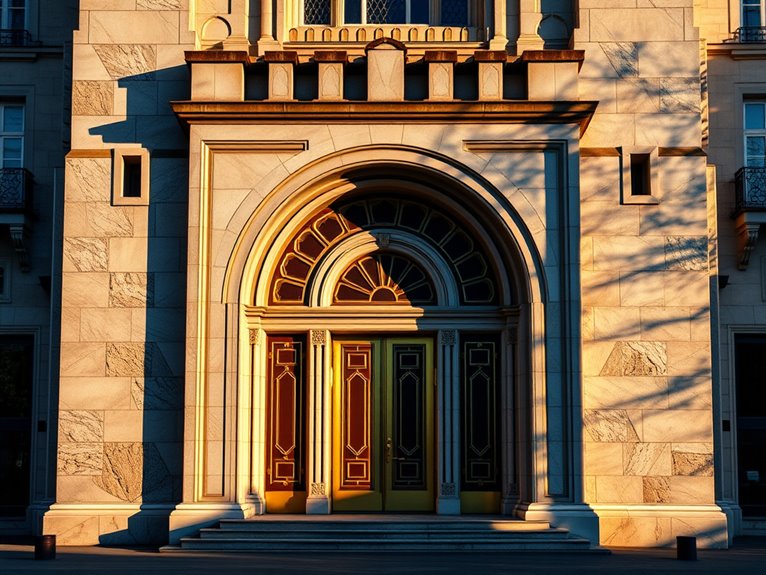
Nestled in the prestigious 16th arrondissement of Paris, Saint-Pierre de Chaillot stands as a remarkable representation of Art Deco ecclesiastical architecture, yet remains surprisingly overlooked by most tourists. This striking church, completed in 1938, represents a bold departure from traditional Parisian church design, combining modern geometric patterns with religious symbolism in a way that's uniquely representative of its era.
While millions flock to Notre-Dame and Sacré-Cœur, Saint-Pierre de Chaillot offers visitors a chance to explore one of Paris's most significant 20th-century religious buildings without the overwhelming crowds. The church's distinctive facade, adorned with Art Deco sculptures and reliefs, tells the story of Saint Peter's life through modernist artistic expression, while its interior showcases an impressive blend of traditional Catholic imagery with contemporary design elements.
Quick Facts:
- Opening Hours: Daily 8:00 AM – 7:00 PM
- Admission: Free
- Best Visiting Time: Weekday mornings for ideal lighting
- Photography: Allowed without flash
- Location: 31 Avenue Marceau, 75116 Paris
- Nearest Metro: Alma-Marceau (Line 9)
- Accessibility: Wheelchair accessible
- Dress Code: Respectful attire required
The Facade:
The church's monumental facade stands out with its stark geometric lines and Art Deco reliefs created by Henri Bouchard. The central tympanum depicts Christ giving the keys to Saint Peter, executed in a distinctly modern style that sets it apart from traditional church sculptures. Visit during early morning hours when the rising sun illuminates the limestone surface, bringing out intricate details often missed in flat lighting.
Interior Architecture:
The vast nave features soaring columns and innovative lighting solutions typical of Art Deco design. The church's most remarkable feature is its unique combination of traditional Christian iconography with modernist architectural elements. Look for the hidden geometric patterns in the ceiling design – a secret feature often overlooked by casual visitors.
Stained Glass Windows:
The church houses exceptional stained glass windows created by Jacques Grüber, one of the leading artists of the Art Deco movement. Unlike traditional Gothic church windows, these feature bold, geometric patterns and surprisingly vibrant colors. The best time to view them is during late afternoon when the setting sun creates dramatic light effects.
Pro Tips:
Plan your visit for Tuesday or Thursday mornings when local tour groups are least likely to be present. The church's acoustic properties are exceptional, so try to time your visit during one of the regular organ recitals (typically held on Sunday afternoons). For photography enthusiasts, the dramatic shadows cast by the geometric architecture are most pronounced between 10 AM and noon.
Practical Advice:
While the church is open daily, religious services take precedence over tourism. Check the schedule posted at the entrance for mass times and plan accordingly. The immediate neighborhood offers excellent dining options, making it ideal to combine your visit with lunch at one of the nearby cafes. Street parking is limited, so using public transportation is recommended. For the best experience, approach the church from Avenue Marceau to appreciate the full impact of its imposing facade.
La Maison De Verre: the Revolutionary Glass House

Standing as a beacon of early modern architecture, La Maison de Verre (House of Glass) revolutionized residential design when it was completed in 1932. This extraordinary building, designed by Pierre Chareau in collaboration with Bernard Bijvoet and Louis Dalbet, represents one of the most significant architectural innovations of the 20th century, seamlessly blending industrial materials with domestic comfort.
Located in Paris's 7th arrondissement, this masterpiece showcases an unprecedented use of glass block walls, mechanical fixtures, and sliding metal screens. The building's unique construction – inserted beneath occupied apartments while preserving the upper floors – demonstrates remarkable engineering ingenuity and stands as a reflection to architectural problem-solving at its finest.
Quick Facts:
- Visiting Hours: Limited to pre-arranged tours, typically Tuesdays and Thursdays
- Cost: €45-80 per person, depending on group size
- Tour Duration: 90 minutes
- Photography: Limited, no flash photography allowed
- Accessibility: Not wheelchair accessible
- Language: Tours available in English and French
- Booking: Minimum 2 months advance reservation required
The Glass Facade:
The building's most striking feature is its translucent glass block facade, comprising thousands of Nevada glass blocks arranged in a steel grid framework. This revolutionary design allows natural light to flood the interior while maintaining privacy. The facade appears to glow from within at night, creating an ethereal lantern effect in the quiet Parisian street.
Insider tip: Visit during late afternoon in winter months when the interplay between natural and artificial light creates the most dramatic visual effects.
Interior Innovation:
The three-story interior features retractable stairs, movable screens, and rotating storage units – all mechanized using industrial components. The original owner, Dr. Jean Dalsace, used the ground floor as his medical practice, while the family resided in the upper floors. These distinct spaces showcase different applications of the industrial aesthetic.
Insider tip: Look for the original heating system's exposed pipes, which double as sculptural elements throughout the house.
Pro Tips:
Booking a private tour offers the most thorough experience, as guides can focus on specific architectural elements of interest. The best photographs can be captured during morning tours when natural light streams through the glass blocks most effectively. Consider visiting during shoulder seasons (March-April or September-October) when the light quality is ideal and tour groups are smaller.
Practical Advice:
Remember that this is still a partially private residence, so tours follow strict guidelines. Wear comfortable, flat shoes as there are many stairs to navigate. Bring a small notebook rather than relying on photography to document the experience. Most importantly, book well in advance through official channels, as this is one of Paris's most exclusive architectural tours with extremely limited availability.
The Innovative Architecture of Fondation Louis Vuitton
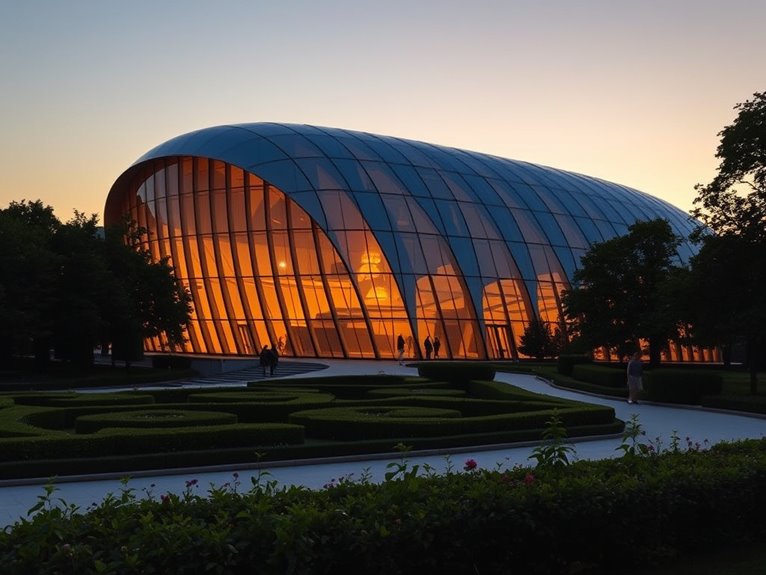
Standing boldly in Paris's Bois de Boulogne, the Fondation Louis Vuitton represents a masterful fusion of art, architecture, and innovation. Designed by legendary architect Frank Gehry, this cultural institution opened in 2014 and immediately established itself as one of Paris's most striking contemporary landmarks. The building's sail-like glass structure, comprising 3,600 panels, seems to float above the surrounding landscape, creating an ethereal presence that both contrasts with and complements its natural surroundings.
This architectural marvel serves as both a museum and cultural center, housing an impressive collection of contemporary art while itself standing as a symbol of modern architectural possibilities. The structure's revolutionary design pushes the boundaries of what's possible in building construction, utilizing advanced digital modeling and innovative engineering solutions to create its complex geometries and seemingly impossible angles.
Quick Facts:
- Opening Hours: 11 AM – 8 PM (closed Tuesdays)
- Best visiting time: Late afternoon for ideal lighting
- Admission: €16-20 (varies by exhibition)
- Photography: Allowed without flash
- Accessibility: Fully wheelchair accessible
- Best season: Spring/Fall for comfortable outdoor viewing
- Transport: Shuttle service from Place Charles de Gaulle
The Building's Exterior
The structure's most distinctive feature is its collection of twelve glass "sails" that create a dynamic silhouette changing throughout the day as light conditions shift. These massive glass panels, supported by wooden beams, create a vessel-like appearance that seems to drift through the park's greenery. Located at 8 Avenue du Mahatma Gandhi, the building is best photographed during golden hour when sunlight plays dramatically across its surfaces.
The Interior Experience
The interior spaces span four floors and feature 11 galleries of varying sizes, offering 3,850 square meters of exhibition space. The building's unique architecture creates unexpected viewing angles and light effects that enhance the art-viewing experience. An insider tip: visit the upper terraces just before sunset for spectacular views of Paris and La Défense district.
Pro Tips:
To truly appreciate this architectural masterpiece, plan your visit for late afternoon when the changing light creates the most dramatic effects on the glass exterior. Consider booking a guided architecture tour (available in multiple languages) to understand the technical innovations behind the building's construction. The building is less crowded during weekday mornings, allowing for unobstructed views and photography opportunities.
Practical Advice:
Pre-booking tickets online is essential during peak season (April-October). The Foundation can be reached via dedicated shuttle buses from Place Charles de Gaulle, but consider combining your visit with a morning exploration of the Bois de Boulogne park. Remember that the building's glass structure can create greenhouse effects on sunny days, so dress in layers and bring water during summer months.
